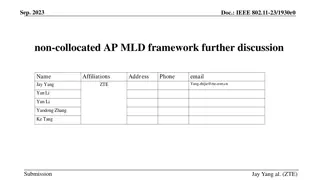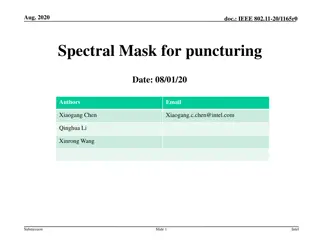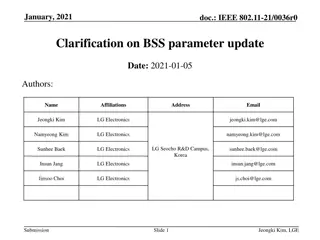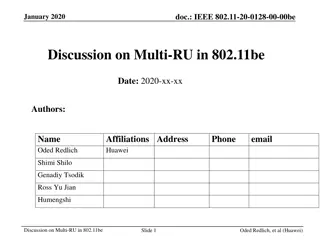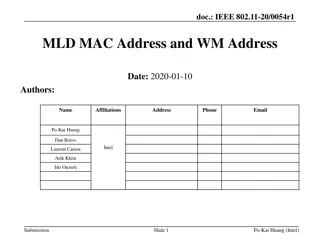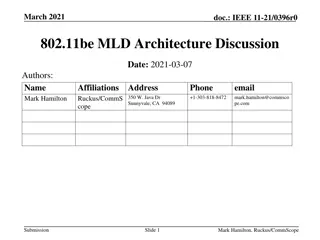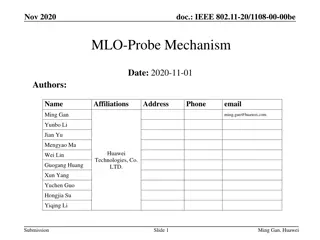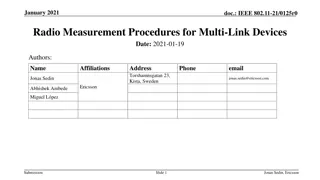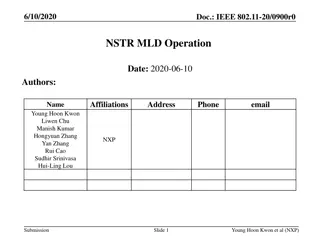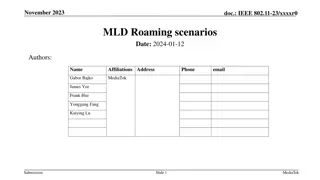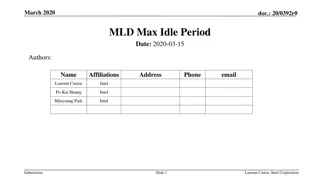IEEE 802.11be MLD Architecture Discussion
The document discusses the architecture of MLD (Multicast and Local Delivery) within the IEEE 802.11be framework. It highlights how MLD will align with existing 802.11 basic architecture, emphasizing the management of access to PHY and media for both AP and non-AP devices. The goal is to integrate MLD seamlessly while allowing for device choice between MLD and 802.11 associations.
Download Presentation

Please find below an Image/Link to download the presentation.
The content on the website is provided AS IS for your information and personal use only. It may not be sold, licensed, or shared on other websites without obtaining consent from the author.If you encounter any issues during the download, it is possible that the publisher has removed the file from their server.
You are allowed to download the files provided on this website for personal or commercial use, subject to the condition that they are used lawfully. All files are the property of their respective owners.
The content on the website is provided AS IS for your information and personal use only. It may not be sold, licensed, or shared on other websites without obtaining consent from the author.
E N D
Presentation Transcript
July 2020 doc.: IEEE 802.11-20/1122r1 802.11be Architecture/Association Discussion Date: 2020-08-06 Authors: Name Joseph LEVY Affiliations InterDigital Communication, Inc. InterDigital Communication, Inc. Address 111 W 33rd Street New York, NY 10120 111 W 33rd Street New York, NY 10120 Phone +1.631.622.4139 email joseph.levy@interdigital.com Xiaofei WANG xiaofei.wang@interdigital.com Submission Slide 1 Joseph Levy (InterDigital)
July 2020 doc.: IEEE 802.11-20/1122r1 Abstract 802.11 TGbe has been discussing MLDs for several months, but there has been little discussion of how MLD will fit in the 802 architecture. Top down design concepts may help progress the MLD work. This contribution discusses an MLD architecture that is well aligned with the current 802.11 basic architecture and will hopefully allow many existing 802.11 features to be reused to support MLD operation. Submission Slide 2 Joseph Levy (InterDigital)
July 2020 doc.: IEEE 802.11-20/1122r1 802.11 Basic Architecture/Association (review) Both the AP and non-AP STA are logical entities An association defines a SAP to SAP connection between an AP MAC SAP to a non-AP MAC SAP (providing a service that allows frames received from the upper layer at a MAC SAP to be passed via the MAC/PHY over the wireless media to another PHY/MAC to its MAC SAP where it is passed to the upper layers) Reassociation is a means to redefine a SAP to SAP connection to either the same or different AP MAC SAP and a non-AP MAC SAP while maintaining some association status (e.g. security/IP address). Disassociation is a means of tearing down a SAP to SAP connection. 802.11be should use/align with these existing functions as much as possible. Slide 3 Submission Joseph Levy (InterDigital)
July 2020 doc.: IEEE 802.11-20/1122r1 802.11be MLD Architecture Discussion The introduction of the MLD concept will define an MLD MAC SAP An MLD MAC SAP of an AP MLD will connect to higher layers via the DS (for non-GLK APs) serving the same purpose as the current MAC SAP The MLD MAC SAP of an non-AP MLD will connect to higher layers via the LLC sublayer, also serving the same purpose as the current MAC SAP. The MLD MAC (lower and upper) will manage all aspects of access to the PHY and media (this applies to both the AP MLD and non-AP MLD) This architecture is an extension of the current 802.11 architecture for all non-GLK STAs (AP and non-AP STA) This architecture will support a device (e.g. non-AP MLD) being able to choose between MLD associations and 802.11 associations (non-MLD) Submission Slide 4 Joseph Levy (InterDigital)
July 2020 doc.: IEEE 802.11-20/1122r1 Current Basic 802.11 Architecture (non-GLK) Local Higher Layer Entities 802.1x PAE 802.1x PAE LPD/EPD LPD/EPD LPD/EPD 802.1AC convergence function 802.1AC convergence function 802.1AC convergence function DA address filtering DSAF Distribution System (DS) Non-AP AP (U) (C) (DS SAP) (U) (C) IEEE 802.1X Controlled and Uncontrolled Port Filtering (Optional) (M) IEEE 802.1X Controlled and Uncontrolled Port Filtering (Optional) (M) MAC MAC STA PHY PHY Wireless Media Submission Slide 5 Joseph Levy (InterDigital)
July 2020 doc.: IEEE 802.11-20/1122r1 Proposed MLD 802.11be Architecture Local Higher Layer Entities 802.1x PAE 802.1x PAE LPD/EPD LPD/EPD LPD/EPD 802.1AC convergence function 802.1AC convergence function 802.1AC convergence function DA address filtering DSAF Distribution System (DS) Non-AP AP (U) (C) (U) (C) (DS SAP) IEEE 802.1X Controlled and Uncontrolled Port Filtering (Optional) (M) IEEE 802.1X Controlled and Uncontrolled Port Filtering (Optional) (M) Upper MLD MAC Upper MLD MAC (m) (m) (m) (m) (m) (m) MAC MAC STA Lower MAC 3 Lower MAC 2 Lower MAC 1 Lower MAC 1 Lower MAC 2 Lower MAC3 PHY 3 PHY 2 PHY 1 PHY 1 PHY 2 PHY 3 Wireless Media Submission Slide 6 Joseph Levy (InterDigital)
July 2020 doc.: IEEE 802.11-20/1122r1 FST Architecture For Reference Local Higher Layer Entities 802.1x PAE 802.1x PAE LPD/EPD LPD/EPD LPD/EPD 802.1AC convergence function 802.1AC convergence function 802.1AC convergence function DA address filtering DSAF Distribution System (DS) Non-AP AP (U) (C) (U) (C) (DS SAP) IEEE 802.1X Controlled and Uncontrolled Port Filtering (Optional) (M) IEEE 802.1X Controlled and Uncontrolled Port Filtering (Optional) (M) Transparent FST Entity Transparent FST Entity (M2) (M1) (M1) (M2) MAC MAC MAC Channel 2 MAC Channel 1 STA MAC Channel 1 MAC Channel 2 PHY Channel 2 PHY Channel 1 PHY Channel 1 Note for FST: Security keys, sequence counter, and PN counters are shared between Channel 1 and 2 entities PHY Channel 2 At any moment only one of the MAC SAPs (M1 or M2) is mapped to the MAC SAP of the FST STA (M) Wireless Media Submission Slide 7 Joseph Levy (InterDigital)
July 2020 doc.: IEEE 802.11-20/1122r1 Possible AP MLD/ Non-AP MLD Associations Assuming the architecture shown on the Proposed MLD 802.11be Architecture slide with an AP MLD that can support 3 links and a non-AP MLD that can support 3 links: The non-AP MLD can associate with: The AP MLD with 3 links The AP MLD with 2 links (there are 3 possible 2 link configurations) The AP MLD with 1 link (3 possible) this is standard current 802.11 association Therefore each of configuration needs an identifier (e.g. a MAC address) The identifier will be associated with a specific configuration, the configuration will provide the number and parameters of the links. The non-AP MLD will associate using the identifier to a specific configuration Hence the non-AP MLD only need to use association, reassociation, and disassociation services to manage its link configuration with the AP MLD. Submission Slide 8 Joseph Levy (InterDigital)
July 2020 doc.: IEEE 802.11-20/1122r1 Conclusion The proposed MLD architecture: 1. Is a natural extension to the current 802.11 architecture 2. Allows the current association, reassociation, and disassociation services to be used to manage MLD connections 3. Proposes the use of an identifier (MAC address) to define the MLD configuration 4. Allows for reuse of other defined 802.11 services with only minor updates Submission Slide 9 Joseph Levy (InterDigital)



